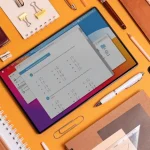Page Contents
- 1 1. Create a Dedicated Workspace (Even if You Live in a Studio)
- 2 2. Use the Right Tools for Communication and Collaboration
- 3 3. Set Boundaries That Work
- 4 4. Manage Your Time Without Losing Your Mind
- 5 5. Prioritize Mental Health (Because Burnout Is Real)
- 6 6. Choose Productivity Apps That Do the Work for You
- 7 7. Stay Visible and Connected with Your Team
- 8 8. Upgrade Your Tech Setup (It’s Worth It)
- 9 9. Build a Routine That Works for You
- 10 10. Keep Learning, Growing, and Adapting
- 11 Final Thoughts: Navigating Your Remote Work Journey with This Guide to Remote Work
Let’s be honest — remote work sounds like the dream, right? Rolling out of bed, grabbing your coffee, skipping traffic, and somehow still being productive from your kitchen table. But if you’ve done it (and I have), you know it’s not always that simple.
In this ultimate guide to remote work success, I’m pulling together everything that’s helped me (and plenty of others) stay sane, stay productive, and — most importantly — feel like we’re really working and not just pretending to in pajama bottoms.
We’ll go over the real-life tools, habits, and mindset shifts that matter. No fluff. Just what’s working in 2025 for freelancers, remote teams, and anyone trying to build structure in a work-from-anywhere life. Whether you’re new to remote life or just trying to level up, this one’s for you.
1. Create a Dedicated Workspace (Even if You Live in a Studio)
I’ll say it, working from your couch feels amazing, for the first week. But by day ten? Your back’s angry, your brain’s scattered, and your “work” hours bleed into Netflix time.
Even if you’re living in a one-bedroom apartment or sharing space with family, carving out a consistent work zone (a corner desk, a fold-out table, anything) signals your brain: “This is where I focus.”
In my experience, putting on headphones, lighting a candle, or even using a specific mug while working makes it feel more official. It’s not about perfection — it’s about consistency. That tiny shift can majorly boost your remote work productivity.
🔑 Key Tips:
- ✅ Use room dividers, bookshelves, or even curtains to define your workspace.
- ✅ Keep your workspace minimal — only what you need to work.
- ✅ Invest in a comfy chair — your back will thank you.
- ✅ Avoid working from bed (your brain needs separation).
- ✅ Make it feel personal but not distracting — plants, art, or a small lamp work great.
2. Use the Right Tools for Communication and Collaboration
If you’ve ever had a Slack thread go nuclear or spent 30 minutes digging for a Zoom link, you already know how much communication tools matter.
Apps like Slack, Zoom, Notion, and ClickUp aren’t just trendy — they’re what keep remote teams from falling apart. I rely on Notion for tracking my shared projects and Zoom for weekly syncs. But honestly? The best tool is the one your team will use.
Look for tools that keep things organized, searchable, and as low-friction as possible. Trust me, fewer “Where’s that file?” messages = a happier workday.
🔑 Key Tips:
- ✅ Use Slack or Microsoft Teams for fast, organized messaging.
- ✅ Use Slack or Microsoft Teams for fast, organized messaging.
- ✅ Set status updates (like “Deep Work Mode”) to signal availability.
- ✅ Use collaborative docs like Google Docs for real-time editing.
- ✅ Schedule regular check-ins to stay aligned without micromanaging.
- ✅ Record async video updates (Loom or Clip) instead of meetings when possible.
- ✅ Create shared calendars or task boards (Notion, Trello, ClickUp) for clarity.
3. Set Boundaries That Work
This one took me years to learn. Remote work doesn’t end unless you end it. You might think you’re being productive by replying to messages at 10 PM, but all it does is burn you out slowly.
Here’s what helped me: I set clear “office hours,” even if they’re a little flexible. I also use Do Not Disturb like it’s my best friend. And if I’m working from home, I change clothes at the end of the workday. Yes, really.
Boundaries aren’t about being rigid, they’re about protecting your energy so you can show up better when it counts.
🔑 Key Tips:
- ✅ Define and communicate your work hours clearly to your team and housemates.
- ✅ Use a visual indicator (like a sign or light) when you’re “in work mode.”
- ✅ Don’t feel guilty about saying no to midday chores or errands.
- ✅ Silence personal notifications during work time, and work ones during personal time.
- ✅ Physically shut your laptop or close your workspace at the end of the day.
- ✅ Use apps like Freedom or Cold Turkey to block distractions.
4. Manage Your Time Without Losing Your Mind
Let me guess — your to-do list is never-ending, your browser has 17 tabs open, and half your “workday” disappears into emails. Yep, been there.
One thing that changed the game for me? Time blocking. I started assigning chunks of time for specific tasks — writing, calls, admin stuff — and suddenly I wasn’t drowning in distractions. Apps like Google Calendar, Clockify, or even a simple Pomodoro timer helped me stay on track (well, most days).
You won’t get it perfect, and that’s fine. But having a loose structure helps your day feel like a workday, which boosts motivation and — oddly — leaves you feeling more relaxed.
🔑 Key Tips:
- ✅ Use time-blocking to assign chunks of your day to specific tasks.
- ✅ Start the day with a short plan — what’s the 1st thing you must get done?
- ✅ Group similar tasks together to avoid constant switching.
- ✅ Use timers like Pomodoro (25 mins work, 5 mins break) for focus.
- ✅ Track your time for a week to see where it’s going.
- ✅ Leave buffer time between meetings or calls to reset.
5. Prioritize Mental Health (Because Burnout Is Real)
No one talks about the isolation part of remote work. But it sneaks up on you — suddenly you haven’t spoken to anyone in person for days, and you’re questioning your entire life over a cold cup of coffee.
That’s why mental health has to be part of your remote work plan. I’ve started taking actual lunch breaks (like away from screens), walking outside once a day, and using tools like Headspace or Calm to reset my brain when things get fuzzy.
Also? Talk to people. Message a friend. Join a virtual coworking session. Connection keeps you grounded — and productivity follows.
🔑 Key Tips:
- ✅ Take regular breaks away from your screen — walk, stretch, or breathe.
- ✅ Don’t skip lunch or stay “online” all evening.
- ✅ Make time for non-work hobbies that recharge you.
- ✅ Talk openly about burnout with teammates or managers.
- ✅ Try mindfulness apps like Headspace, Calm, or Insight Timer.
- ✅ Use mental health days if your company offers them — seriously.
6. Choose Productivity Apps That Do the Work for You
I’m a little obsessed with testing out new productivity apps (it’s kinda my thing), but let me be real — most of them are overkill. The best ones are the ones that quietly make your day smoother without demanding too much.
In this Guide to Remote Work, I stick with tools like Notion, Trello, Todoist, and Motion — my go-to picks in 2025. Notion helps me track everything in one spot — projects, notes, even meal plans (don’t judge). Motion auto-schedules my day based on what’s urgent. It’s weirdly satisfying.
Whatever you choose, the goal is simple: let the tool think for you, so you can save brainpower for the stuff that matters.
🔑 Key Tips:
- ✅ Use Todoist, TickTick, or Sunsama for smart task management.
- ✅ Use Notion or Evernote for second-brain-style knowledge keeping.
- ✅ Automate repetitive tasks using Zapier or Make.com.
- ✅ Use calendar sync tools to keep personal and work life aligned.
- ✅ Try voice-to-text apps for quicker note-taking or ideas.
- ✅ Don’t overload — choose 2–3 tools and master them.
7. Stay Visible and Connected with Your Team
I’m a little obsessed with testing out new productivity apps (it’s kinda my thing), but let me be real — most of them are overkill. The best ones are the ones that quietly make your day smoother without demanding too much.
In this Guide to Remote Work, I stick with tools like Notion, Trello, Todoist, and Motion — my go-to picks in 2025. Notion helps me track everything in one spot — projects, notes, even meal plans (don’t judge). Motion auto-schedules my day based on what’s urgent. It’s weirdly satisfying. These apps have been game-changers on my remote work journey.
Whatever you choose, the goal is simple: let the tool think for you, so you can save brainpower for the stuff that matters.
🔑 Key Tips:
- ✅ Share regular updates in your team chat — short and useful.
- ✅ Be active in social channels or virtual coffee breaks.
- ✅ Keep your calendar updated and visible.
- ✅ Use video when possible to keep a human connection.
- ✅ Give teammates props — visibility is mutual.
- ✅ Ask for feedback and share yours regularly.
8. Upgrade Your Tech Setup (It’s Worth It)
You don’t need a $2,000 standing desk and three monitors (though hey, dream setup, right?). But investing in the right gear pays off, especially when you’re working from home full-time.
At minimum, you’ll want:
- A solid Wi-Fi connection
- A comfortable chair
- Noise-canceling headphones (game-changer during meetings)
- A decent webcam and mic (especially if you’re client-facing)
I upgraded my chair and lighting last year, and not even kidding, my productivity went up. It’s hard to focus when your back hurts or your screen glare makes you squint all day. Comfort isn’t a luxury; it’s part of the job.
🔑 Key Tips:
- ✅ Get a second monitor — it seriously boosts efficiency.
- ✅ Use a laptop stand, external keyboard, and mouse for ergonomics.
- ✅ Use a proper webcam and mic for clearer calls.
- ✅ Get a surge protector with USB ports — small upgrade, big help.
- ✅ Try a Wi-Fi extender or Ethernet cable if your connection lags.
- ✅ Declutter cords with organizers or simple cable clips.
9. Build a Routine That Works for You
Here’s the thing: remote work doesn’t mean copying your old 9-to-5 schedule. That’s kind of the point. In this Guide to Remote Work, you get to experiment until you find a rhythm that works for you — whether that’s early mornings, late nights, or split shifts.
I tried the “miracle morning” thing. Spoiler: not for me. But I did find that starting with a walk or journaling helps me ease into focus. Figure out your flow and stick with it — consistency creates structure, and structure supports focus.
Oh, and don’t skip breaks. You’re not a machine (even if your calendar thinks you are).
🔑 Key Tips:
- ✅ Schedule your most important work when you feel most alert.
- ✅ Create a start-of-day ritual (coffee, review goals, silence notifications).
- ✅ Include time for deep work, meetings, and breaks.
- ✅ Have a consistent wind-down — plan tomorrow, close tabs, walk away.
- ✅ Don’t pack every hour — leave some flexibility.
- ✅ Adjust your routine monthly based on what’s working or not.
10. Keep Learning, Growing, and Adapting
Remote work in 2025 isn’t a set-it-and-forget-it situation. Tech changes, industries shift, and — let’s be honest — you change too. In this Guide to Remote Work, one of the best ways to stay sharp is to keep learning.
Take short courses on platforms like LinkedIn Learning, Skillshare, or Coursera. Follow newsletters or podcasts in your niche. Ask your employer (if you have one) about remote-friendly training programs. You don’t have to go back to school — just stay curious.
In my case, I picked up project management basics last year. Didn’t think I needed it… until I needed it.
The point is, your skills are your currency. Keep investing.
🔑 Key Tips:
- ✅ Take online courses — even short ones can spark fresh thinking.
- ✅ Follow remote work blogs, newsletters, or YouTube channels.
- ✅ Try new tools or workflows once a month — but don’t overdo it.
- ✅ Set personal growth goals (read a book, attend a webinar).
- ✅ Reflect on what’s helped or hurt your productivity recently.
- ✅ Stay curious — growth is part of long-term remote success.
Remote work in 2025 isn’t a set-it-and-forget-it situation. Tech changes, industries shift, and — let’s be honest — you change too. In this Guide to Remote Work, one of the best ways to stay sharp is to keep learning.
Take short courses on platforms like LinkedIn Learning, Skillshare, or Coursera. Follow newsletters or podcasts in your niche. Ask your employer (if you have one) about remote-friendly training programs. You don’t have to go back to school — just stay curious.
In my case, I picked up project management basics last year. Didn’t think I needed it… until I needed it.
The point is, your skills are your currency. Keep investing.



